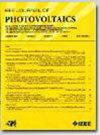Electronic Band Offset Determination of Oxides Grown by Atomic Layer Deposition on Silicon
IF 2.5
3区 工程技术
Q3 ENERGY & FUELS
引用次数: 1
Abstract
Minimizing electrical losses at metal/silicon interfaces in high-efficiency single-junction silicon solar cells requires the use of carrier-selective passivating contacts. The electronic barrier heights at the insulator/silicon interface are necessary for calculating the probability of quantum tunneling of charge carriers at these interfaces. Thus, precise knowledge of these parameters is crucial for the development of contact schemes. Using a photoemission-based method, we experimentally determine the electronic band offsets of Al 2 O 3 , HfO 2 and SiO 2 layers grown by atomic layer deposition (ALD) on silicon. For Al 2 O 3 /Si, we determine a valence band offset (Δ硅原子层沉积法生长氧化物的电子带偏移测定
在高效单结硅太阳能电池中,最小化金属/硅界面的电损耗需要使用载流子选择性钝化触点。绝缘体/硅界面上的电子势垒高度是计算这些界面上载流子量子隧穿概率所必需的。因此,这些参数的精确知识对于接触方案的发展至关重要。利用光电发射方法,实验测定了原子层沉积(ALD)在硅上生长的Al2O3、HfO2和SiO2层的电子能带偏移量。对于Al2O3/Si,我们确定了价带偏移(ΔEV)和导带偏移(ΔEC)分别为3.29±0.07 eV和2.24±0.13 eV。对于HfO2/Si, ΔEV和ΔEC分别为2.67±0.07 eV和1.81±0.21 eV,对于SiO2/Si, ΔEV和ΔEC分别为4.87±0.07 eV和2.61±0.12 eV。利用计算机辅助设计模拟技术,我们结合我们的实验结果来估计在不同介电层厚度下将获得的接触电阻率。我们发现,为了达到100 mΩ·cm2的接触电阻率基准,对于p型多晶硅基的空穴选择接触,假设从文献中获得的空穴隧道质量,Al2O3层的厚度应不大于1.65 nm。相应地,对于HfO2和SiO2,确定了1.4 nm的上限作为厚度阈值,以便在高性能硅光伏电池中利用这些ald生长层的触点。
本文章由计算机程序翻译,如有差异,请以英文原文为准。
求助全文
约1分钟内获得全文
求助全文
来源期刊

IEEE Journal of Photovoltaics
ENERGY & FUELS-MATERIALS SCIENCE, MULTIDISCIPLINARY
CiteScore
7.00
自引率
10.00%
发文量
206
期刊介绍:
The IEEE Journal of Photovoltaics is a peer-reviewed, archival publication reporting original and significant research results that advance the field of photovoltaics (PV). The PV field is diverse in its science base ranging from semiconductor and PV device physics to optics and the materials sciences. The journal publishes articles that connect this science base to PV science and technology. The intent is to publish original research results that are of primary interest to the photovoltaic specialist. The scope of the IEEE J. Photovoltaics incorporates: fundamentals and new concepts of PV conversion, including those based on nanostructured materials, low-dimensional physics, multiple charge generation, up/down converters, thermophotovoltaics, hot-carrier effects, plasmonics, metamorphic materials, luminescent concentrators, and rectennas; Si-based PV, including new cell designs, crystalline and non-crystalline Si, passivation, characterization and Si crystal growth; polycrystalline, amorphous and crystalline thin-film solar cell materials, including PV structures and solar cells based on II-VI, chalcopyrite, Si and other thin film absorbers; III-V PV materials, heterostructures, multijunction devices and concentrator PV; optics for light trapping, reflection control and concentration; organic PV including polymer, hybrid and dye sensitized solar cells; space PV including cell materials and PV devices, defects and reliability, environmental effects and protective materials; PV modeling and characterization methods; and other aspects of PV, including modules, power conditioning, inverters, balance-of-systems components, monitoring, analyses and simulations, and supporting PV module standards and measurements. Tutorial and review papers on these subjects are also published and occasionally special issues are published to treat particular areas in more depth and breadth.
 求助内容:
求助内容: 应助结果提醒方式:
应助结果提醒方式:


